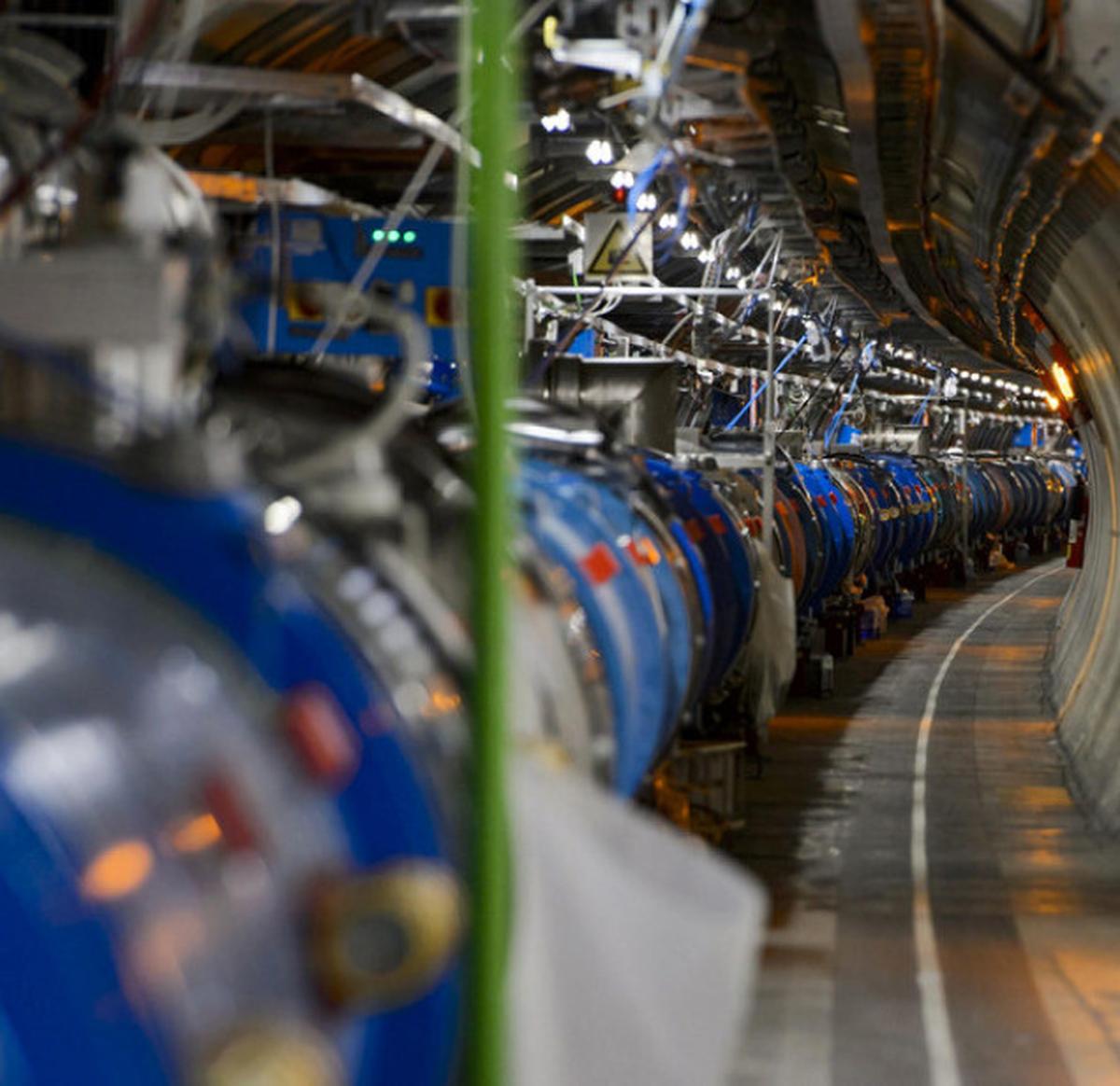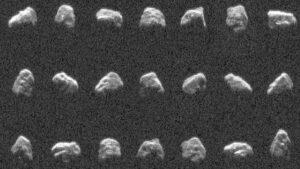Scientists at the world’s largest physics experiment have reported the most precise measurement yet of the most massive subatomic particle we know. The discovery sounds esoteric, but it wouldn’t be an understatement to say it has universe-wide implications.
The Greek philosopher Empedocles hypothesized 2,400 years ago that matter can be broken down into smaller and smaller pieces until we are left with air, earth, fire and water. Since the early 20th century, physicists have broken matter into smaller and smaller pieces to find instead many different subatomic particles—enough to fill a zoo.
A top quark
Instead of a “smaller” particle, modern particle physicists deal with elusive particles.
More energetic particles often decay into lower energy ones. The greater the difference in energy between that of the particle and its decay products, the less time the particle exists in its original form and the faster it decays. By mass-energy equivalence, a more massive particle is also a more energetic particle. And the most massive particle that scientists have discovered so far is the top quark.
It is 10 times heavier than a water molecule, about three times heavier than a copper atom and 95% of a complete caffeine molecule.
As a result, the top quark is so unstable that it can decay into lighter, more stable particles in less than 10-25 seconds.
The mass of a top quark is very important in physics. The mass of a particle is equal to the sum of the masses obtained from multiple sources. An important source for all elementary particles is the Higgs field, which permeates the entire universe. The “field” is like a sea of energy and the excitations in the field are called particles. Thus, for example, a Higgs field excitation is called a Higgs boson, just as an electron can be considered an “electron field” excitation.
All these fields interact with each other in specific ways. When the “electron field” interacts with the Higgs field at energies much lower than 100 GeV, for example, the electron particle will acquire some mass. The same is true for other elementary particles. (The GeV, or giga-electron-volt, is a unit of energy used in the context of subatomic particles: 1 joule = 6.24 billion GeV.) Elucidating this mechanism won Francois Englert and Peter Higgs the 2013 Nobel Prize in Physics.
If the top quark is the most massive subatomic particle, it is because the Higgs boson interacts most strongly with it. By measuring the mass of the top quark as precisely as possible, physicists can then learn a lot about the Higgs boson as well.

“Physicists are intrigued by the top quark mass because there is something strange about it,” said Nirmal Raj, a particle theorist and assistant professor at the Indian Institute of Science, Bengaluru. The Hindu. “On the one hand, it is the closest to the mass of the Higgs boson, which is what one would ‘naturally’ expect before measuring it. On the other hand, everyone else [particles like it] are much, much lighter, which makes one wonder if the top quark is actually a strange rather than a ‘natural’ species.”
The universe as we know it
But the rabbit hole is deeper.
Physicists are keen to study the Higgs boson also because of its own mass, which it acquires by interacting with other Higgs bosons. Importantly, the Higgs boson is more massive than expected – meaning the Higgs field is more energetic than expected. And since it permeates the universe, it can be said that the universe is more energetic than expected. This “expectation” comes from calculations that physicists have performed, and they have no reason to believe that they are wrong. Why does the Higgs field have so much energy?
Physicists also have a theory about how the Higgs field originally formed (at the birth of the universe). If they’re right, there’s a small but non-zero chance that one day in the future the field will go through a sort of self-tuning that lowers its energy and changes the universe in drastic ways.
They know that today the field has some potential energy and there is a way to shed some of it so that it has less and becomes more stable. There are two ways to reach this steady state. One is for the field to first gain some energy before losing more, like climbing one side of a mountain to enter a deeper valley on the other side. The other is if an event called quantum tunneling occurs, where the potential energy of the field will “tunnel” through the mountain instead of having to climb over it and fall into the valley there.
That’s why Stephen Hawking said in 2016 that the Higgs boson could mean “the end of the universe” as we know it. Even if the Higgs field were slightly stronger than it is now, the atoms of most chemical elements would be destroyed, taking stars, galaxies and life on Earth with it. But while Hawking was technically correct, other physicists were quick to say that the frequency of the tunneling event was 1 in 10100 years.
The mass of the Higgs boson is 126 GeV/c2 (a unit used for subatomic particles) — is also sufficient to maintain the universe in its present state; anything else and “the end” would have come. Such a fine-tuned value is obviously curious, and physicists would like to know which natural processes contribute to it. The top quark is part of this picture because it is the most massive particle, in a way the Higgs boson’s closest friend.
“Precisely measuring the mass of the top quark has implications for whether our universe will disappear with a tunnel,” Dr Raj said.

Finding the top quark
Physicists discovered the top quark in 1995 at a US particle accelerator called the Tevatron, measuring its mass at 151-197 GeV/c2. The Tevatron was shut down in 2011; physicists continued to analyze the collected data and updated the value three years later to 174.98 GeV/c2. Other experiments and research groups have produced more accurate values over time. On June 27, physicists at the Large Hadron Collider (LHC) in Europe reported the most accurate figure yet: 172.52 GeV/c2.
Measuring the mass of a top quark is difficult when its lifetime is about 10-25 seconds. Typically, a particle beater produces an ultra-hot soup of particles. If a top quark is present in this soup, it will quickly decay into specific groups of lighter particles. Detectors watch for these events and when they happen, track and record their properties. Finally, computers collect this data and physicists analyze it reconstruct the physical properties of the top quark.
Scientists learn what to expect at each point in this process based on complex mathematical models and must contend with many uncertainties. Many of the devices used in these machines also incorporate state-of-the-art technology; when the engineers improve them further, the results of the physicists also improve that much.
The researchers will now incorporate the measurement of the top quark’s mass into calculations that inform our understanding of the particles of our universe. Some of them will use it to search for an even more accurate value. Accurately measuring the mass of the top quark is also key to understanding whether some other particle with a mass close to that of the top quark might be hiding in the data, according to Dr. Raj.
This is a premium article available exclusively to our subscribers. Read 250+ such premium articles every month
You have reached your limit of free articles. Please support quality journalism.
You have reached your limit of free articles. Please support quality journalism.
You have read {{data.cm.views}} outside {{data.cm.maxViews}} free articles.
This is your last free article.



